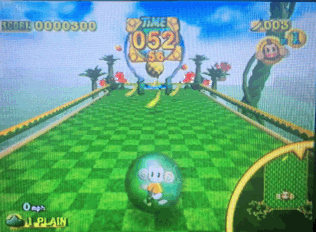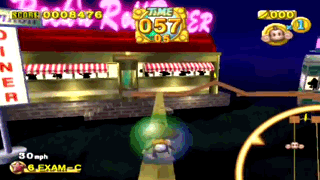The Decline of Super Monkey Ball
November 25th, 2016
“Because you’re asking ‘Why? Why are they in the balls?’ With this story, you’re going to find out why they’re in the balls.”
—Marty Caplan, Producer of Super Monkey Ball Adventure
Back in 2006 fans and critics universally panned Super Monkey Ball Adventure labelling the game as the first misfire in the series. Given quotes like the one above, it’s not hard to understand why. In hindsight, Super Monkey Ball Adventure‘s failure signalled the series’s decline over subsequent games. Yet for all its flaws, Adventure was a spin-off from the main series developed by an external studio trying their hand at a new concept. The game is far removed from the main line Monkey Ball games and their developers in Japan.
Rather I would argue that Super Monkey Ball‘s decline began from the second game in the series. Super Monkey Ball 2 added fast-moving objects, big drops, and mazes to the pool of precision-based challenges. Dr Bad Boon and songs about poo aside, the game’s new-fangled story mode defocused the gameplay through its do-what-you-want organisation of level challenges. Super Monkey Ball Deluxe, a greatest hits spin on the first two titles, only added to the bloat with 43 new levels—a middling compilation defined by expansive mazes, flat gimmicks, and few fresh ideas. Not helping matters the lack of the Gamecube’s octagonal grooves in the PS2 and Xbox analogue sticks diminished the series’s iconic precision input. Super Monkey Ball Adventure may have been the punching bag, but the series’s real decline started three years earlier.
Chaotic Approach to Levels
Super Monkey Ball Deluxe consists of two types of levels: tight navigational challenges which test the player’s ability to finely manoeuvre their monkey ball to the goal and ineffective gimmick levels which hinge on risk or chance. The latter group tend to feature the following elements:
Sporadic jumping challenges and fast-moving objects which can knock the player off stage with little notice. The combination of the default behind-the-monkey camera angle, slow camera tracking, and fast movement speed inhibit the game’s ability to frame the action when the player quickly turns, falls, or makes a sporadic action. Unfortunately, some levels are constructed so as to elicit such perilous manoeuvrs.
Mazes and dull switch puzzles. Given the default camera position, the player cannot easily see above walled areas. Thus without the information necessary to make informed decisions, most mazes boil down to guesswork. Some mazes spread themselves out for no apparent reason other than to force the player to move through a highly scaffolded environment.
Random stage conceptions (for example, a giant wall textured in the Monkey Ball website address or an insect walking along a cylinder) instead of challenges designed around the navigational nuances of the game system.
To substantiate my argument, I’ve compiled a list of the worst offending levels from Super Monkey Ball Deluxe. Most examples have a video link, so you can click through to see the level played out in full.
Levels with Fast-moving Objects
Levels with Bad Puzzles
Crazy Maze 9-9
Levels with Big Jumps and Falls
Levels with Poorly-implemented Gimmicks
In challenge mode the player cannot filter between the navigational challenges and ineffective gimmick levels, rather the two types are mixed in together. As a result, the effort you invest in manoeuvring through the obstacle courses can easily be undermined by the chance involved in many of the gimmicky stages. Furthermore, the luck involved in these levels also promotes a more reckless style of play which the player may transfer over to the dexterity-focused navigational challenges. These non-serious challenges can therefore have a potentially negative impact on player motivation and concentration.
Organisation of Level Challenges
Super Monkey Ball 2‘s story mode defocuses the gameplay by giving the player too much control over their progression. For each world the player must complete ten out of a pool of twenty levels of varying difficulty. The selection screen includes difficulty rankings for each level and players can choose to complete whichever levels they like in whichever order they like. The player therefore has an unprecedented degree of freedom over the experience, being able to scale the difficulty as they see fit. The extra freedom sounds good on paper, but in reality the average player lacks the aptitude and strategies to successfully regulate their own learning.
Regardless of one’s experience with a particular series or genre, players simply don’t know what the next set of challenges will look like, let alone what conceptual understandings or skills they’ll need going forward. If I were to trust someone to teach me a game, I would probably trust the people who made the game over myself, the novice. And so it is that the freedom to play whichever level one wishes should actually read as “the freedom to drive the difficulty curve off a cliff”.
If there’s one consolation, the level select does allow players to skip past the problematic levels discussed above. So in the end I personally didn’t mind the extra leeway.
Camera Design
Super Monkey Ball Deluxe‘s camera is perfectly functional for most stages, but can prove troublesome for particular types of challenges. The camera sits behind the monkey ball and doesn’t like to move from its default position. If the ball turns, the camera will maintain its original reference point. This behaviour keeps the camera work clean and non-intrusive. Once the player releases the stick, though, the camera will swivel around the monkey ball until it arrives back in its default position. The rotation begins at a reasonable pace and then slows to a crawl as it comes in for landing behind the monkey ball. The player therefore controls the camera through intentional releases of the analogue stick following a turn.
The camera—privileging the default position—will sometimes end its rotation before it arrives behind the monkey ball, leaving the player to contend with a slightly skewed perspective. I’m not exactly sure if this issue is related to the release, the turn, or something else—but it exists nonetheless. The speed and responsiveness of the camera’s tracking exert an “invisible” but powerful influence on Super Monkey Ball‘s gameplay.
The camera’s behaviour is crucial in 3D navigational games like Super Monkey as the camera establishes the nature of space. Super Monkey Ball employs a tracking camera (as opposed to say a series of specifically programmed cameras as in, say, Super Mario 3D Land), and so a significant element of play involves aligning the camera, monkey ball, and path ahead. By triangulating these elements, the player can simplify a game challenge.
The video above demonstrates what triangulation looks like in action. The player moves the monkey ball directly in front of the tightrope. They then attempt to cross the narrow bridge as the camera is arriving in behind the monkey ball. This is a brazen move. Although the monkey ball is dead ahead of the tightrope, the camera is skewed at an angle making the challenge harder to read cognitively. The camera then arrives and the player fails to recalibrate causing them to slip and fail the challenge. The player messes up the second go. But for the third attempt, they wait for the camera to move into alignment. Then all they need to do is push the analogue stick forward and keep a steady hand. As this example illustrates, the camera defines the nature of space and by extension the difficulty of the challenge.
In levels where the player must turn 90 degrees or more, the camera becomes a source of great frustration. 90 degree turns require a significant realignment of the camera and the player often cannot afford to have the perspective off at an angle. As the topmost animated gif so neatly demonstrates, the player makes an input and then waits 5 seconds or more for the game to provide feedback—all the while the timer continues to count down overhead. If the camera then decides not to arrive directly behind the monkey ball, the player must re-attempt the turn (tilting away from and then towards the tightrope) as they wrestle the camera into place. Something as simple as lining up the camera can feel like you’re fighting your way out of a perpetual state of flux.
Additional Comments
- In story mode, the player can retry stages as much as they like. No threat of failure means no pressure on the player to concentrate and play well. Without anything on the line, I found that I tended to play more recklessly.
- Story mode contrasts strongly with challenge mode, a rigid series of successively more difficult courses. Even though challenge mode squashes story mode’s problematic freedom, I still wish the difficulty incline were more forgiving. The level variation also doesn’t prepare the player for some of the game’s trickier manoeuvres. If stages were organised more tightly around level concepts (curves, tightropes, stairs, bowls, etc), then the player’s learning would be more focused and they would better be able to commit new learning to memory.
- The textures in the PS2 version are horribly grainy and the load times in the stage select menu and between levels are atrocious. The Gamecube games look clean and have seemingly no loading times. The practice menu offers the same functionality as the stage select, but without the bad loading times, so I suspect that the PS2 has a hard time reading the miniature 3D models of the stages into memory.
- The octagonal barrier around the Gamecube’s analog stick make the Monkey Ball games easier to control as they lock the stick in place, extremely useful for rolling in a straight line. On the DualShock, though, the round barrier makes it easy to slide off angle.
- To play Super Monkey Ball well, one needs a strong synchronisation between body and mind. The last thing you want is to be distracted by a vibrating washing machine or steam from a giant pot…but alas, the misadventures of Dr. Bad Boon.
[Originally written in 2014]
Additional Reading







 Game Design Companion: A Critical Analysis of Wario Land 4 - $7.99
Game Design Companion: A Critical Analysis of Wario Land 4 - $7.99 Level Design: Processes and Experiences
Level Design: Processes and Experiences Speed Boost: The Hidden Secrets Behind Arcade Racing Design - $5.99
Speed Boost: The Hidden Secrets Behind Arcade Racing Design - $5.99 Adventures in Games Analysis: Volume I - $5.99
Adventures in Games Analysis: Volume I - $5.99







